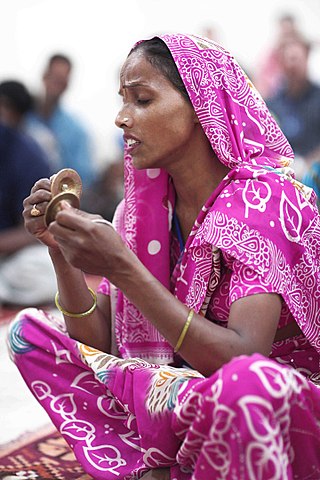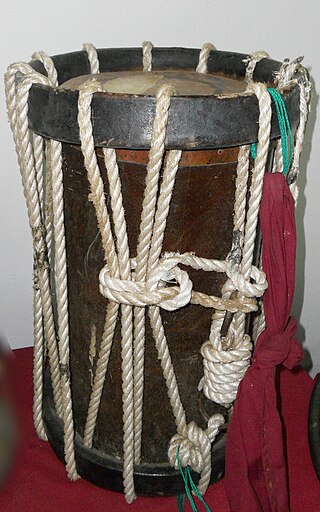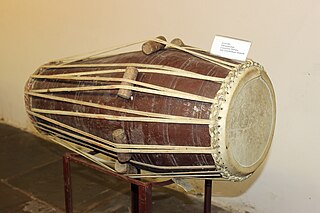Jhaptal is a tala of Hindustani music. It presents quite a different rhythmical structure from Teental, unlike which it is not symmetrical. It is used in madhyalay (medium-tempo) Khyal.
Jhaptal is a tala of Hindustani music. It presents quite a different rhythmical structure from Teental, unlike which it is not symmetrical. It is used in madhyalay (medium-tempo) Khyal.
Jhaptal is a 10-beat pattern used in raga exposition. It has ten beats in four divisions (vibhag), of 2-3-2-3, the third of which is the khali, or open division. To follow the tal the audience clap on the appropriate beat, which in jhaptal is beats 1, 3 and 8 (the first beat in each full division). A wave of the hand indicates beat 6, the first beat of the khali section.
Series of Claps and Waves: clap, 2, clap, 2, 3, wave, 2, clap, 2, 3
There are 4 vibhags: The split for Jhaptaal : 2 / 3 / 2 / 3
Theka:
x Dhi Na | 2 Dhi Dhi Na |0 Tin Na | 3Dhi Dhi Na |
In Devanagari : धी ना - धी धी ना -- ती ना - धी धी ना .
It has a characteristic pattern of bols (theka).
Note the bols used for the first beat of each division: Dhi, is played at the beginning of the first, second and final divisions; for the khali section, Na - a right hand bol - is used to indicate that the division is open.

Polyrhythm is the simultaneous use of two or more rhythms that are not readily perceived as deriving from one another, or as simple manifestations of the same meter. The rhythmic layers may be the basis of an entire piece of music (cross-rhythm), or a momentary section. Polyrhythms can be distinguished from irrational rhythms, which can occur within the context of a single part; polyrhythms require at least two rhythms to be played concurrently, one of which is typically an irrational rhythm. Concurrently in this context means within the same rhythmic cycle. The underlying pulse, whether explicit or implicit can be considered one of the concurrent rhythms. For example, the son clave is poly-rhythmic because its 3 section suggests a different meter from the pulse of the entire pattern.
In music, an ostinato is a motif or phrase that persistently repeats in the same musical voice, frequently in the same pitch. Well-known ostinato-based pieces include classical compositions such as Ravel's Boléro and the Carol of the Bells, and popular songs such as Donna Summer and Giorgio Moroder's "I Feel Love" (1977), Henry Mancini's theme from Peter Gunn (1959), The Who's "Baba O'Riley" (1971), The Verve's "Bitter Sweet Symphony" (1997), and Flo Rida's "Low" (2007).

In music and music theory, the beat is the basic unit of time, the pulse, of the mensural level. The beat is often defined as the rhythm listeners would tap their toes to when listening to a piece of music, or the numbers a musician counts while performing, though in practice this may be technically incorrect. In popular use, beat can refer to a variety of related concepts, including pulse, tempo, meter, specific rhythms, and groove.

Applause is primarily a form of ovation or praise expressed by the act of clapping, or striking the palms of the hands together, in order to create noise. Audiences usually applaud after a performance, such as a musical concert, speech, or play, as a sign of enjoyment and approval.
Ektal or Ektaal is a tala in Indian music. It is commonly used in classical music like kheyal, and semi-classical forms like Rabindra Sangeet. In ektal the 12 matras are divided into 6 vibhags of two matras each. Ektal is played in Drut gatti. This tala is mostly played by the use of tabla. One more tala similar to Ektal is Chowtal which is played with the use of Pakhavaj,Ektaal is the tabla counterpart of Chowtaal. Many beautiful Kaida are played in Ektal. But Ektal is mostly played for Vilambit.
Vibhag represents a duration of rhythmic phrasing in Indian classical music made up of a certain number of beats. They are the rough equivalent of bars in western music, but instead of always being equal subdivisions of the tala, they can be uneven. In certain traditions of Indian music, any number of beats may form a Vibhag. Usually the beats will be in two, three, or four. They should be designated either with a clap or a wave of the hand. The meaning of the word Bhag from is parts. The actual measure of the Vibhag is borders or boundaries or boundary lines, in short not in continuity or not continuous. The talas in Tabla or in any other percussion instrument in classical music have Vibhagas to get a track of the beats on Matras on which the singer or player is singing or playing on. For example taking different talas,
Teentaal is the most common taal of Hindustani music, and is used for drut. It is symmetrical and presents a very simple rhythmic structure against which a performance can be laid. It is of 16 beats with 4/4/4/4/ pattern and 4 divisions.There are 3 claps(tali) and 1 gap(khali).

A tala literally means a 'clap, tapping one's hand on one's arm, a musical measure'. It is the term used in Indian classical music similar to musical meter, that is any rhythmic beat or strike that measures musical time. The measure is typically established by hand clapping, waving, touching fingers on thigh or the other hand, verbally, striking of small cymbals, or a percussion instrument in the Indian subcontinental traditions. Along with raga which forms the fabric of a melodic structure, the tala forms the life cycle and thereby constitutes one of the two foundational elements of Indian music.
Dadra is associated with the Hindustani classical music of the Indian subcontinent.
Dhamar is one of the talas used in Hindustani classical music from the Indian subcontinent. It is associated with the dhrupad style and typically played on the pakhawaj and also tabla.

The Chenda is a cylindrical percussion instrument originating in the state of Kerala and widely used in Tulu Nadu of Karnataka and Tamil Nadu in India. In Tulu Nadu, it is known as chende. It is greatly identified as a cultural element in Kerala and Tulu Nadu.

The pakhavaj is a barrel-shaped, two-headed drum, originating from the Indian subcontinent, the oldest version of double sided drums and its descendants are mridangam of Southern India and kendang of Maritime Southeast Asia and other South Asian double-headed drums. Its older forms were made with clay.
Konnakol is the art of performing percussion syllables vocally in South Indian Carnatic music. Konnakol is the spoken component of solkattu, which refers to a combination of konnakol syllables spoken while simultaneously counting the tala (meter) with the hand. It is comparable in some respects to bol in Hindustani music, but allows the composition, performance or communication of rhythms. A similar concept in Hindustani classical music is called padhant.
Rupak Tala or also known as Roopak Taal is a popular tala in Hindustani music that is common in Bhajans and Geets. It has seven matras (beats) in three vibhags (divisions). Unlike the popular Tintal, the vibhags of Rupak Tala are not of equal length. Also, both the khali and sam of Rupak Tala fall on the first matra.
Yakshagana Tala, is a rhythmical pattern in Yakshagana that is determined by a composition called Yakshagana Padya. Tala also decides how a composition is enacted by dancers. It is similar to Tala in other forms of Indian music, but is structurally different from them. Each composition is set to one or more talas, and as a composition is rendered by Himmela, the percussion artist(s) play supporting the dance performance. Tala is maintained by the singer using a pair of finger bells.

A tabla is a pair of hand drums from the Indian subcontinent. Since the 18th century, it has been the principal percussion instrument in Hindustani classical music, where it may be played solo, as an accompaniment with other instruments and vocals, or as a part of larger ensembles. It is frequently played in popular and folk music performances in India, Bangladesh, Afghanistan, Pakistan, Nepal and Sri Lanka. The tabla is an essential instrument in the bhakti devotional traditions of Hinduism and Sikhism, such as during bhajan and kirtan singing. It is one of the main qawwali instruments used by Sufi musicians. The instrument is also featured in dance performances such as Kathak. Tabla is a rhythmic instrument.
Keharwa or Kaharva is an 8 beat tala of Hindustani music. Keherwa has many variations including dhumaali, "bhajani", and qawwali.
Quintuple meter or quintuple time is a musical meter characterized by five beats in a measure.
Jhoomra is a tala of Hindustani music. Jhoomra tala has 14 beats. Jhoomra is often used in the vilambit or ati-vilambit (slow) Khyal.
A Theka literally means "support, prop". The term also refers to a musical composition in classical Indian music for percussion instruments that establish a rhythm (Chanda), beats (Matras) and the metric cycle of beats (Tala) in a performance. An example is the theka of Dadra Tal: "Dha Dhi Na / Na Ti Na".